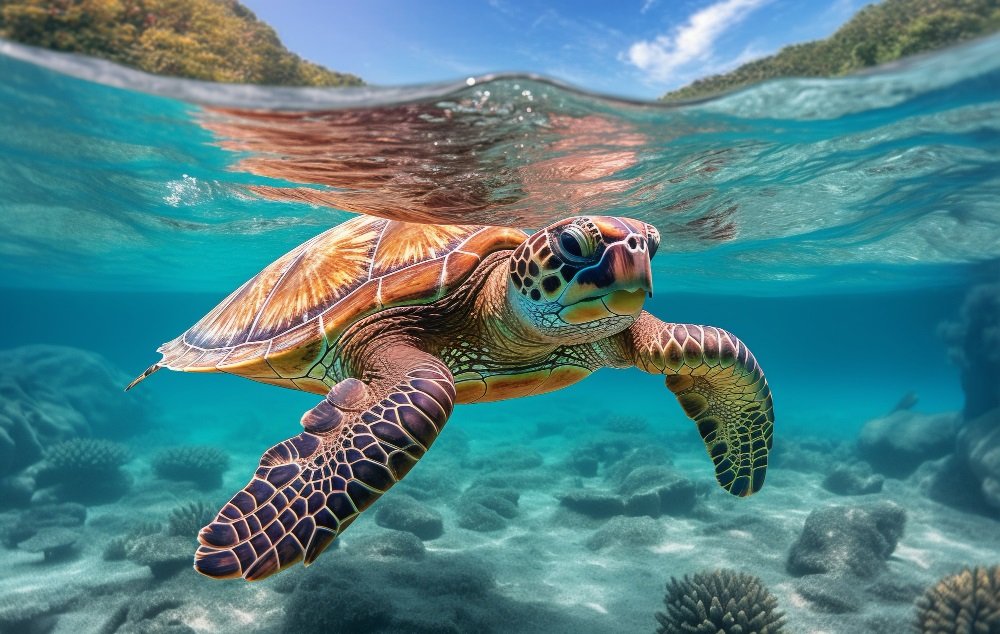Sea turtles are ancient mariners, having roamed our oceans for millions of years. These magnificent creatures play a vital role in maintaining healthy marine ecosystems. Understanding their life cycle and the challenges they face is crucial for their conservation. One critical aspect is their survival rate, as sea turtles face numerous threats from the moment they hatch until adulthood.
What Percentage of Sea Turtles Survive?
The journey of a sea turtle from egg to adulthood is fraught with peril. Only a small percentage of hatchlings successfully navigate these obstacles and reach maturity.
Factors Affecting Sea Turtle Survival
Several factors contribute to the low survival rate of sea turtles, including:
- Predation
- Habitat loss
- Pollution
- Climate change
- Fishing gear entanglement
This overview will delve into the complex factors influencing sea turtle survival and explore the conservation efforts aimed at protecting these remarkable animals.
What Percentage Of Sea Turtles Survive?
Sea turtles, ancient mariners that have roamed our oceans for millions of years, face a perilous journey from hatchling to adulthood. Their survival rates are staggeringly low, a testament to the numerous threats they encounter throughout their lives. Understanding these challenges and the factors influencing their survival is crucial for effective conservation efforts.
The Challenges of Sea Turtle Life
Sea turtles face a gauntlet of dangers from the moment they hatch. Their journey to the sea is fraught with obstacles, and their lives in the ocean are constantly threatened by human activities and natural predators.
Nesting and Hatchling Survival
The first hurdle for sea turtles is reaching the ocean. Nesting females return to the same beaches where they were born to lay their eggs, often facing dangers like human disturbance, predation, and habitat loss. Once hatched, the tiny turtles must navigate a treacherous journey across the beach, avoiding predators like crabs, birds, and raccoons. (See Also: What Is Basking For Turtles)
Only a small percentage of hatchlings successfully reach the water. Estimates suggest that less than 1 in 1000 hatchlings will survive to adulthood.
Ocean Predators and Threats
Once in the ocean, young sea turtles face a multitude of predators, including sharks, fish, and marine mammals. They also encounter entanglement in fishing gear, ingestion of plastic debris, and habitat degradation. These threats continue to plague them throughout their lives, making survival a constant struggle.
Factors Influencing Sea Turtle Survival Rates
Several factors contribute to the low survival rates of sea turtles. Understanding these factors is essential for developing effective conservation strategies.
Species Differences
Survival rates vary significantly among different sea turtle species. Loggerhead turtles, for example, have a relatively higher survival rate compared to leatherback turtles. This difference can be attributed to factors like nesting site characteristics, diet, and migratory patterns.
Environmental Conditions
Environmental factors play a crucial role in sea turtle survival. Climate change, rising sea levels, and ocean acidification pose significant threats to their nesting habitats and overall health. Pollution, habitat destruction, and overfishing also impact their food sources and survival.
Human Activities
Human activities are the primary drivers of sea turtle decline. Fishing gear entanglement, accidental capture in nets, and the destruction of nesting beaches are major threats. Pollution from plastic debris, oil spills, and agricultural runoff further endanger their lives.
Conservation Efforts and the Future of Sea Turtles
Recognizing the plight of sea turtles, numerous conservation efforts are underway to protect these magnificent creatures. These efforts focus on addressing the threats they face and ensuring their long-term survival.
Habitat Protection and Restoration
Protecting and restoring sea turtle nesting beaches is crucial for their survival. This involves reducing human disturbance, controlling invasive species, and mitigating the impacts of climate change. (See Also: How Far Do Box Turtles Roam)
Fishing Gear Modifications
Modifying fishing gear to reduce sea turtle bycatch is essential. Turtle excluder devices (TEDs) are nets with special openings that allow turtles to escape, minimizing accidental capture.
Public Education and Awareness
Raising public awareness about the threats facing sea turtles and promoting responsible behaviors is vital. Educating people about the importance of reducing plastic use, supporting sustainable seafood, and respecting nesting beaches can make a significant difference.
International Collaboration
Sea turtles are migratory animals, and their conservation requires international cooperation. Countries along their migratory routes must work together to protect their habitats and address threats.
Recap
Sea turtles face a multitude of challenges throughout their lives, resulting in staggeringly low survival rates. From the moment they hatch, they are vulnerable to predators, habitat loss, and human-induced threats.
Understanding the factors influencing their survival is crucial for effective conservation. By addressing threats like habitat destruction, fishing gear entanglement, and pollution, we can help ensure the survival of these magnificent creatures for generations to come.
International collaboration, public education, and responsible behaviors are essential for the long-term success of sea turtle conservation efforts.
Frequently Asked Questions: Sea Turtle Survival Rates
What is the overall survival rate for sea turtles?
Unfortunately, sea turtles face many threats, and their survival rates are quite low. It’s estimated that only 1 in 1,000 hatchlings will survive to adulthood. (See Also: The Meaning Of Turtles)
What are the biggest threats to sea turtle survival?
Several factors contribute to the low survival rates, including habitat loss, fishing gear entanglement, pollution, climate change, and predation by animals like birds and crabs.
Do different species of sea turtles have different survival rates?
Yes, survival rates can vary between species. Factors like nesting site location, diet, and migratory patterns can influence their chances of survival.
What can be done to improve sea turtle survival?
Many organizations and individuals are working to protect sea turtles. This includes reducing plastic pollution, promoting sustainable fishing practices, creating marine protected areas, and educating the public about sea turtle conservation.
Where can I learn more about sea turtle conservation efforts?
You can find valuable information and ways to get involved with sea turtle conservation through organizations like the Sea Turtle Conservancy, Oceana, and the World Wildlife Fund.


